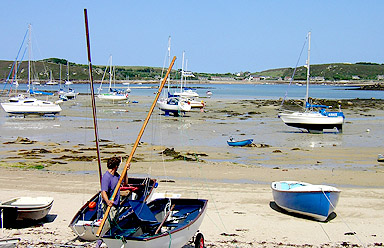|
Tides

Low tide on Bryher, Isle of Scilly, UK. Photo © Chris Pettitt Musical Services. Used by permission. |
Tides are another kind of wave motion in the ocean. Tides are a change in the ocean water level, typically reaching a high and low level twice a day usually occurring about six hours apart. The term for the change from low to high tide is called the "flood tide". The change from high tide to low tide is called the "ebb tide".
Tides result from the pull of gravity; on the earth alone, between the earth and moon and between the earth and the sun. The gravitational pull of the sun on the earth is about 178 times stronger than the gravitational pull on the earth from the moon. However, because of the close proximity of the moon, when compared to the sun, the tidal pull by the moon is over twice that of the sun.
The result of this tidal pull is a bulge in the ocean water almost inline with the position of the moon; one bulge toward the moon and one on the opposite side of the earth, away from the moon. When we observe the tides what we are actually seeing is the result of the earth rotating under this bulge.
Take it to the MAX! Battle of the Bulge
 The change in the water level with the daily tides from location to location results from a many factors. The oceans and shorelines have complex shapes and the depth, and configuration, of the sea floor varies considerably. The change in the water level with the daily tides from location to location results from a many factors. The oceans and shorelines have complex shapes and the depth, and configuration, of the sea floor varies considerably.
As a result, some locations only experience one high and low tide each day, called a diurnal tide. Other locations experience two high and low tides daily, called a semi-diurnal tide. Still, other sites have mixed tides, where the difference in successive high-water and low-water marks differ appreciably.
Another factor in the variation of tides is based on the orbit of the moon around the earth and the earth around the sun. Both orbits are not circles but ellipses. The distance between the earth and moon can vary by up to 13,000 miles (31,000 km). Since the tidal force increase with decreasing distance then tides will be higher than normal when the moon is at its closest point (called perogee) to the earth, approximately every 28 days.
Likewise, the earth's elliptical orbit also causes variations in the sun's pull on the tides as we move from the closest point to the farthest point (called apogee) over the course of a year. And just to complicate things even more, the moon's orbit is inclined 5° to the earth's rotation. So the north/south orientations of the bulge also varies between the northern and southern hemisphere over this same 28-day orbital period.
Take it to the MAX! The Fun Bay of Fundy
 As the moon completes one orbit around the earth (about every 28 days), there are two times in each orbit when the earth, moon and and sun are inline with each other and two times when the earth, moon and sun are at right angles. As the moon completes one orbit around the earth (about every 28 days), there are two times in each orbit when the earth, moon and and sun are inline with each other and two times when the earth, moon and sun are at right angles.
When all three are inline (around full and new moons), the combined effect of the moon's and sun's pull on the earth's water is at its greatest resulting in the greatest ranges between high and low tide. This called a "spring" tide (from the water springing or rising up).
Seven days after either full or new moon, the earth, moon and sun are at right angles to each other. At this time the pull of the moon and the pull of the sun partially cancel each other out. The resulting tide, called a "neap" tide, has the smallest range between high and low tide.
Learn more about tides from the National Ocean Service's Tide FAQ.
Learning Lesson: Moonlight Serenade
|
|





